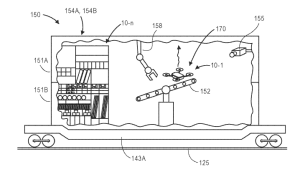Amazon patent graphic for railroad sourcing
“Amazon wants its inventory everywhere”, writes Supply Chain Dive (Nov. 8, 2019). It is expanding its network of fulfillment locations with a focus on intermodal containers. Intermodal-based fulfillment, as Amazon’s patent application describes it, would allow the company to fulfill orders from rail, truck or ship. Here are the steps in the patent:
- 1. Load intermodal container with inventory.
- 2. A robotic system picks and loads items onto drone.
- 3. Launch and retrieval system puts the drone in appropriate position for take-off.
- 4. Drone departs container through opening in the roof.
- 5. Drone travels to a customer’s home, delivers package.
- 6. Drone meets back up with the container at a pre-calculated rendezvous point.
- 7. Variety of sensors track container’s location.
But wait, drones need new batteries, their propellers might break, and without a human in the loop how does this operation keep running smoothly? Amazon thought of this. One of the details included in the patent application is a maintenance container where drones can have a robotic technician replace propellers or batteries. Amazon says containers could be loaded with inventory before the launch of a book or video game in anticipation of demand spikes, placing inventory in locations where it expects orders.
To compete with brick-and-mortar locations, Amazon wants to cut down on delivery time making it just as convenient to hit order on the marketplace as it is to drive down the road. But this requires a complex network of inventory in fulfillment and sortation centers across the country. It has already promised one-day delivery for a variety of SKUs. Amazon claims drones will enable 30-minute delivery. Making this happen will not just require drones, but a vast web of SKUs across the country.
Read more at OM in the News: Amazon Marries Drones and Intermodal
Tag Archives: robotic
Gartner: top 8 supply chain technology trends for 2019
According to Gartner, while many of these supply chain technology trends have not yet been widely adopted, they will have a broad industry impact this year.
Gartner has highlighted the key supply chain technology trends which they warned must not be ignored. Christian Titze, research vice president at Gartner, said: “Within the next five years if half of the large global companies are using some of these technologies in their supply chain operations, it’s safe to say that the technologies will disrupt people, business objectives and IT systems.”
The top 8 supply chain technology trends in 2019 are:
#1 Artificial intelligence (AI)
According to Gartner, AI technology in supply chain operations is all about augmenting workers. Thanks do developments in self-learning and natural language processing, AI is now advanced enough to automate numerous supply chain processes such as predictive maintenance and demand forecasting.
#2 Advanced analytics
Thanks to the increase in IoT data and extended external data sources such as weather or traffic conditions, analytics is going to get a lot more advanced. Gartner predicted that organisations will be able to anticipate future scenarios and make better recommendations in areas such as supply chain planning, sourcing and transportation.
#3 IoT
Gartner has reported seeing more supply chain practitioners exploring the potential of IoT. However, according to Gartner, new IoT applications involve more than just passive sensors.
#4 Robotic process automation (RPA)
Excitement has been building around RPA for some time now, and its place in the enterprise has seen a lot of maturing this year. Like AI, RPA, according to Gartner, is about augmenting workers.
#5 Autonomous things
Autonomous things use AI to automate functions previously performed by humans, such as autonomous vehicles and drones. They exploit AI to deliver advanced behaviours that interact more naturally with their surroundings and with people.
#6 Digital supply chain twin
A digital twin is a digital replica of a physical asset, whether that is a product, person, place or system.
#7 Immersive experience
Augmented reality (AR) and virtual reality (VR) technologies have long been touted as the next big thing. For all its promise mass adoption by enterprises have, in reality, always seemed to be on the horizon.
Read more at Gartner: top 8 supply chain technology trends for 2019
What do you think about this topic? Leave your comment below if you have opinions, and subscribe us to get updates.





